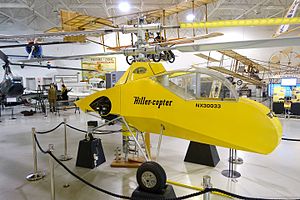Hiller XH-44
The Hiller XH-44 Hiller-Copter (Experimental Hiller, 1944) is an American experimental helicopter designed by Stanley Hiller.
| XH-44 | |
|---|---|
 | |
| Hiller XH-44 replica at the Hiller Aviation Museum | |
| Role | Experimental helicopter |
| National origin | United States |
| Manufacturer | Hiller Aircraft |
| Designer | Stanley Hiller |
| First flight | Unknown (tethered) July 4, 1944 (untethered) |
| Status | Retired |
| Number built | 1 |
Design and development
Stanley Hiller became interested in helicopters in the late 1930s, when he saw pictures of the Focke-Wulf Fw 61 and the Vought-Sikorsky VS-300.[1] He bought every book on helicopter development that he could find, and in the early 1940s he began design work on the XH-44, at the age of 17.[2] The engine was later swapped for a 125 hp Lycoming engine.
The XH-44 featured a pair of contra-rotating rotors which, in its original form, was powered by a 65 hp Franklin engine (de-rated from its original 90 hp).[3] It was the first successful coaxial rotor helicopter to be built in the United States, as well as the first helicopter to use all-metal rotor blades.[3]
Operational history
The XH-44 tipped over on its first tethered test flight with Hiller at the controls, resulting in minor damage. On July 4, 1944, the XH-44 made its first untethered flight at the University of California's football stadium at Berkeley.[3] The helicopter made an appearance during a public demonstration at San Francisco on August 30, 1944.[3]
The success of the XH-44 caught the attention of Henry J. Kaiser, who funded further development of Hiller's rotor system.[3]
Hiller donated the XH-44 to the Smithsonian National Air and Space Museum in 1953.[4] The helicopter was restored in 1974, and in 1997 it was lent back to Hiller and displayed at the Hiller Aviation Museum.[4] The XH-44 is no longer displayed at the Hiller Aviation Museum, although a replica is currently on display at the museum.[5]
Specifications (XH-44)
Data from [3]
General characteristics
- Crew: 1
- Length: 13 ft 4 in (4.06 m)
- Empty weight: 1,244 lb (564 kg)
- Powerplant: × Franklin piston engine, 65 hp (48 kW) (original)
- Powerplant: × Lycoming piston engine, 125 hp (93 kW) (after modification)
- Main rotor diameter: 2× 25 ft (7.6 m)
See also
Aircraft of comparable role, configuration and era
References
- "Hiller XH-44 helicopter - development history, photos, technical data". www.aviastar.org. Retrieved 2020-06-28.
- "Hiller XH-44 Hiller Copter". www.aviation-history.com. Retrieved 2020-06-28.
- McGowen, Stanley S. (2005). Helicopters: An Illustrated History of Their Impact. ABC-CLIO. ISBN 978-1-85109-468-4.
- Skaarup, Harold A. (2003-04-07). Maryland, Virginia, and Washington D.C. Warbird Survivors 2003: A Handbook on Where to Find Them. iUniverse. ISBN 978-1-4620-4749-9.
- "Hiller XH-44". Hiller Aviation Museum. Retrieved 2020-06-28.